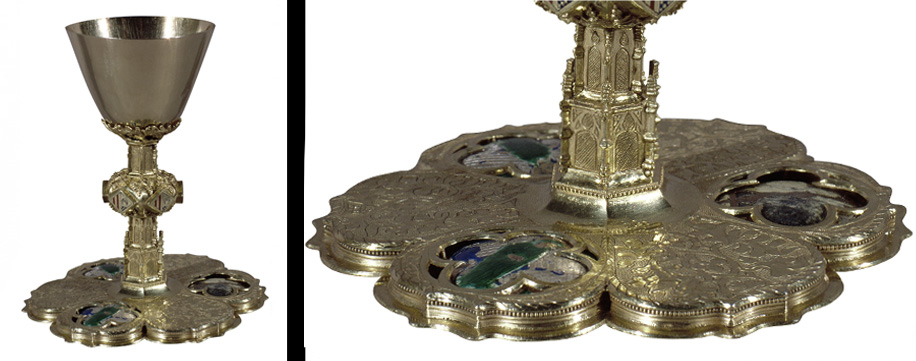Catalunya 1400
The International Gothic Style
A Queen’s patronage

Bernat Daries. Chalice of Maria de Luna.
Between 1396 and 1406.
© Museu Nacional d’Art de Catalunya
Barcelona
Fotògrafs: Calveras/Mérida/Sagristà
Luxury and refinement surrounding the queen
Maria de Luna was the daughter of a noble family from Aragon with close ties to King Peter III the Ceremonious. These were ideal circumstances for a marriage agreement between the two families’ children: Maria and Martí, the future King Martin the Humane. For this reason, at the age of eight, Maria moved to the court in Barcelona, where she was suitably educated until the two were married ten years later, on 13 June 1372.
Elegant by nature, deeply religious and with a good intellectual training, she played an active role in the government of the Crown. In fact, Martin himself recognised her talent when he appointed her as his regent. The court, like many others in Europe, was full of music. Queen Mary herself had musicians assigned to her chamber. A devoted reader, she had a large library in which works of a religious subject matter alternated with classic authors and books of chivalry. It was a luxurious court for a refined queen, who liked to appear in public richly and fashionably dressed, with sumptuous jewels, of which her favourites were brooches and pearls. Her refinement could also be seen in the pomp of her banquets, where abundant food was served on table linen from Vilafranca, with delicate lace, and gold and silver tableware decorated with enamel and precious stones, of which the queen had inherited an extremely rich collection from her mother.
Her private chamber was covered with tapestries from Flanders, silk, velvet curtains embroidered with gold and silver thread, leather chests, a fabulous sideboard and a fan of turkey feathers to relieve the heat in summer. A lover of plants and animals, the queen kept exotic birds and wild animals in her garden, which was full of lemon trees, jasmine, cherry trees and roses.
Sumptuary metalwork
The Chalice of Maria de Luna is a good example of the sumptuary art the silversmith’s workshops of the Crown of Aragon produced in the last years of the 14th century and the first decades of the 15th. These workshops flourished thanks to the constant profusion of commissions of this type for an exclusive and refined clientèle, who purchased items of precious metalwork to satisfy their desire for luxury and, of course, as an investment. One way of raising funds during that period was to pawn or sell items of noble metals or jewellery. These objects are often to be found in the inventories making up the rich patrimonies built up through inheritance, private purchases and donations. In this respect, the royal treasury accounts bear witness to the number of items of precious metal that Martin the Humane pawned following the death of the queen, to pay for her funeral.
The queen’s chapel and the gilded silver chalice
In one of the six lozenges on the knop of the foot of the chalice is the heraldry of Maria de Luna, made up of the royal bands and the waning moon of her lineage, showing that this was a commission for the queen. To date this is the only item known to us of the many objects that could have formed part of her sumptuary dowry, though it might have been an offering by Queen Maria to a church under her protection.
Most pieces of metalwork from the 14th and 15th centuries had hallmarks that vouched for the quality of the metal. The presence of the letters VALEN in a crowned rectangle on one of the lobes of the base show the item came from Valencia. Since the queen made a payment in 1403 to Bernat Dàries, one of the leading metal workers and enamellers of the city of Valencia, for various commissions he had undertaken, many authors identify this master as the creator of the piece.
Although this is a traditional item as regards type, technique and decoration, it has one unusual feature, which is the representation separately, using three translucent enamels, of the protagonists of the Calvary: the Virgin, Christ on the Cross and Saint John the Evangelist, usually all found together in a single scene.
| Artist | Bernat Daries |
|---|---|
| Title | Chalice of Maria de Luna |
| Date | Between 1357-1406 |
| General classification | Liturgical metalwork |
| Material / Tecnique | Silver-gilt, embossed and engraved, cast and translucent enamelled |
| Dimensions | 20, 3 x 15,9 x 16,4 cm |
| Work conserveted in | Barcelona, Museu Nacional d’Art de Catalunya |
